Nursing Peer Teaching: Learning Theories and Competency Assessment
VerifiedAdded on 2023/06/13
|8
|1475
|357
Report
AI Summary
This report outlines a peer teaching lesson plan for nursing education, emphasizing the application of learning theories such as Need Theory to foster cognitive thinking and decision-making skills in students. It considers various learning styles, including analytical and situational approaches, alongside the importance of cultural beliefs in patient communication. The lesson plan focuses on identifying learning needs through assessments, incorporating feedback mechanisms to address strengths and weaknesses, and evaluating learner competence via decision-making abilities and communication effectiveness. The report references relevant literature to support the strategies and models proposed for enhancing nursing education and patient care.
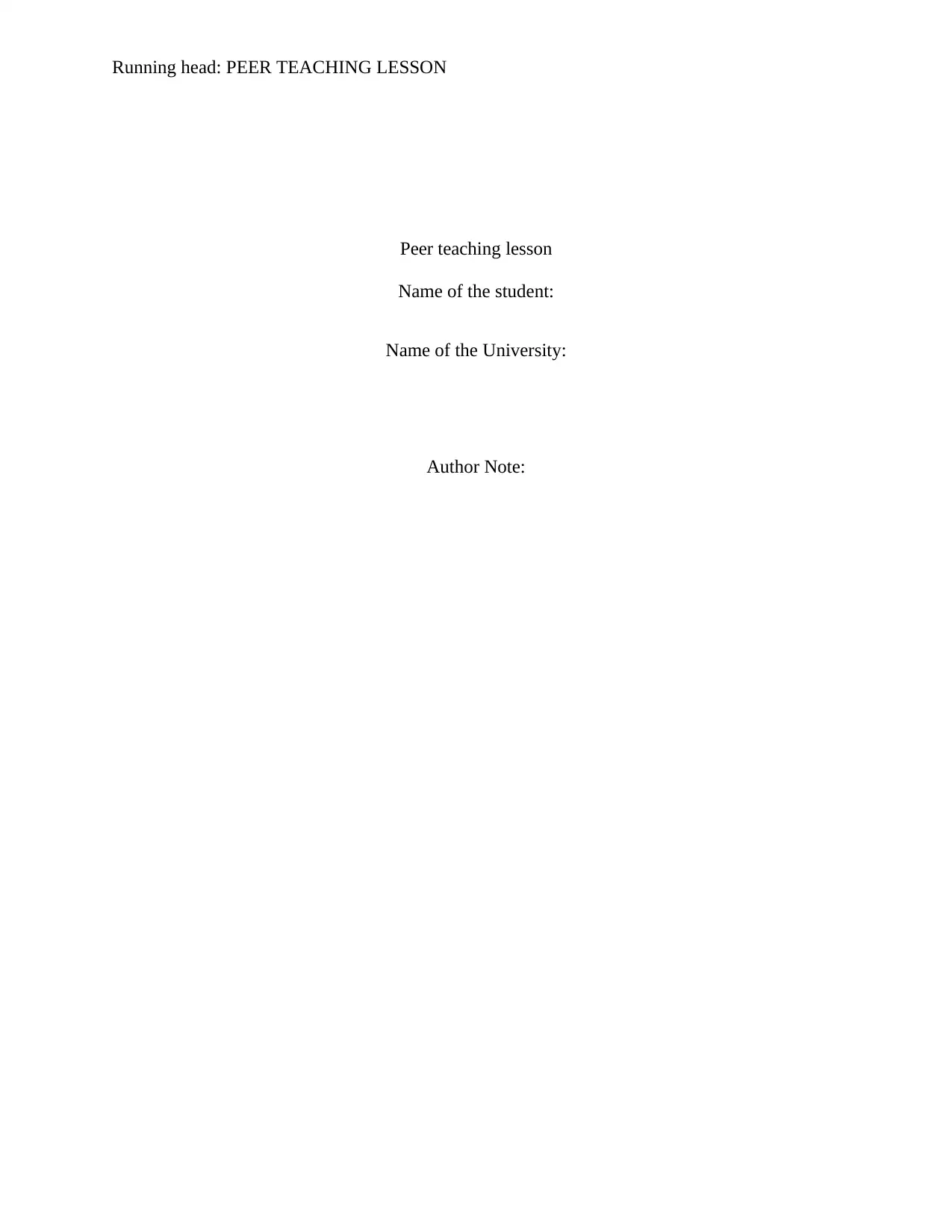
Running head: PEER TEACHING LESSON
Peer teaching lesson
Name of the student:
Name of the University:
Author Note:
Peer teaching lesson
Name of the student:
Name of the University:
Author Note:
Paraphrase This Document
Need a fresh take? Get an instant paraphrase of this document with our AI Paraphraser
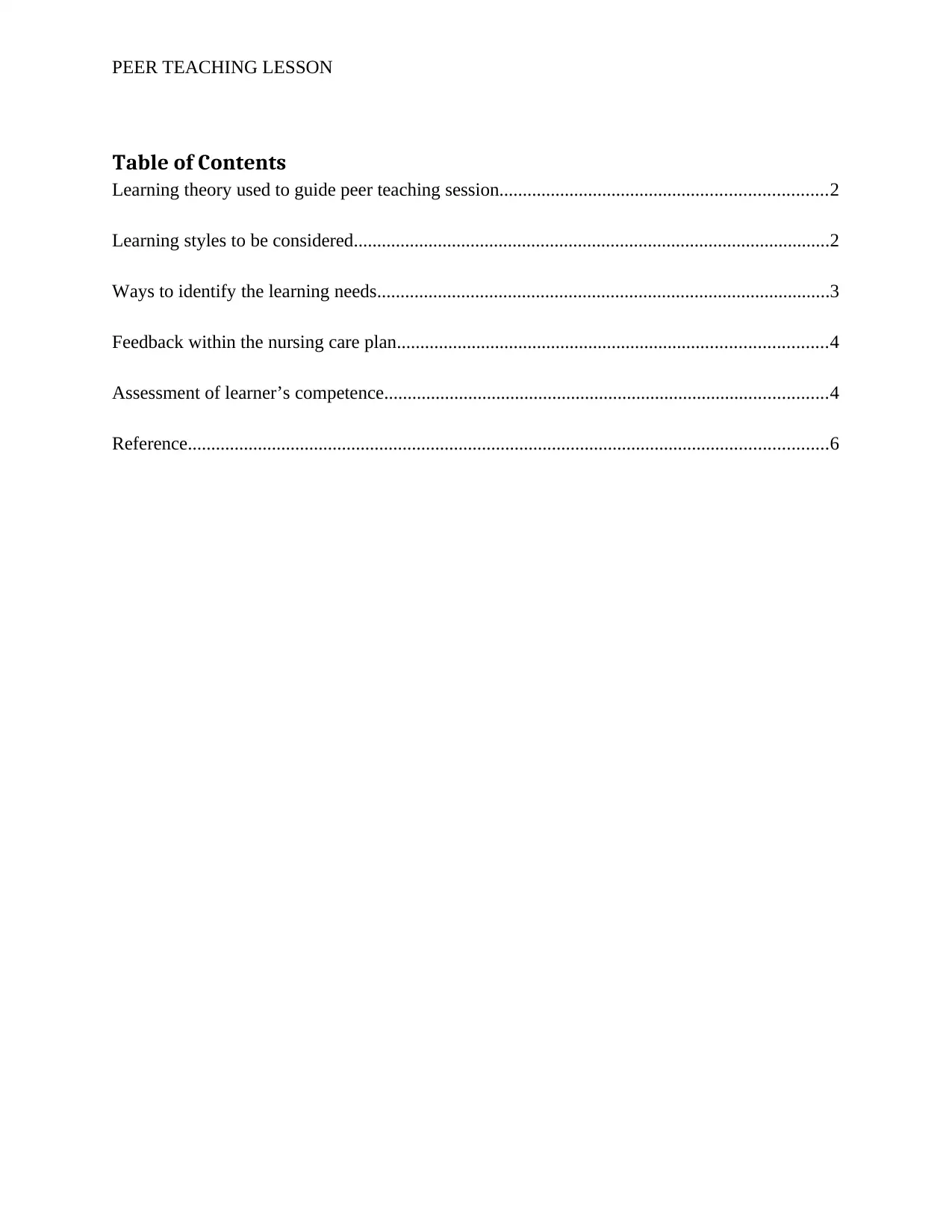
PEER TEACHING LESSON
Table of Contents
Learning theory used to guide peer teaching session......................................................................2
Learning styles to be considered......................................................................................................2
Ways to identify the learning needs.................................................................................................3
Feedback within the nursing care plan............................................................................................4
Assessment of learner’s competence...............................................................................................4
Reference.........................................................................................................................................6
Table of Contents
Learning theory used to guide peer teaching session......................................................................2
Learning styles to be considered......................................................................................................2
Ways to identify the learning needs.................................................................................................3
Feedback within the nursing care plan............................................................................................4
Assessment of learner’s competence...............................................................................................4
Reference.........................................................................................................................................6
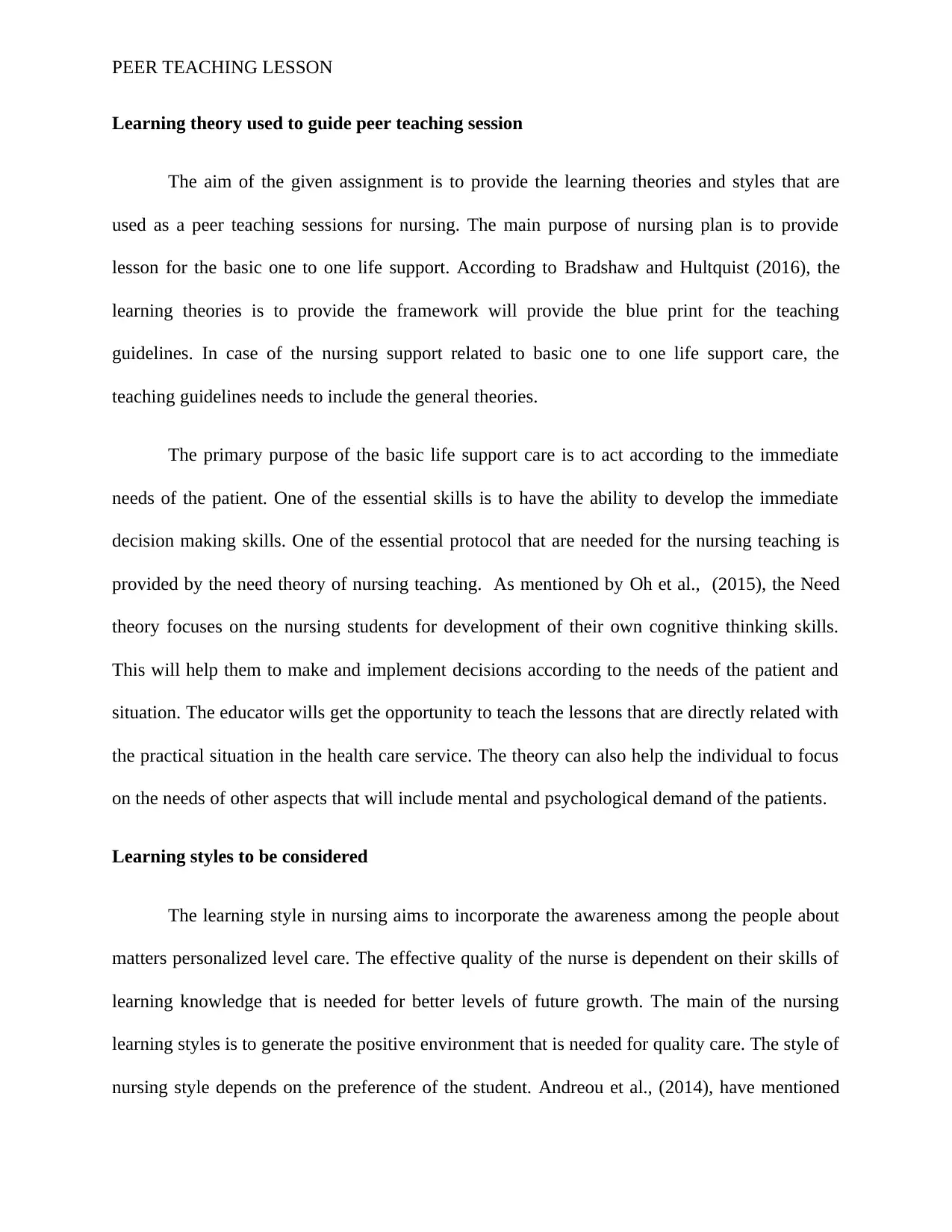
PEER TEACHING LESSON
Learning theory used to guide peer teaching session
The aim of the given assignment is to provide the learning theories and styles that are
used as a peer teaching sessions for nursing. The main purpose of nursing plan is to provide
lesson for the basic one to one life support. According to Bradshaw and Hultquist (2016), the
learning theories is to provide the framework will provide the blue print for the teaching
guidelines. In case of the nursing support related to basic one to one life support care, the
teaching guidelines needs to include the general theories.
The primary purpose of the basic life support care is to act according to the immediate
needs of the patient. One of the essential skills is to have the ability to develop the immediate
decision making skills. One of the essential protocol that are needed for the nursing teaching is
provided by the need theory of nursing teaching. As mentioned by Oh et al., (2015), the Need
theory focuses on the nursing students for development of their own cognitive thinking skills.
This will help them to make and implement decisions according to the needs of the patient and
situation. The educator wills get the opportunity to teach the lessons that are directly related with
the practical situation in the health care service. The theory can also help the individual to focus
on the needs of other aspects that will include mental and psychological demand of the patients.
Learning styles to be considered
The learning style in nursing aims to incorporate the awareness among the people about
matters personalized level care. The effective quality of the nurse is dependent on their skills of
learning knowledge that is needed for better levels of future growth. The main of the nursing
learning styles is to generate the positive environment that is needed for quality care. The style of
nursing style depends on the preference of the student. Andreou et al., (2014), have mentioned
Learning theory used to guide peer teaching session
The aim of the given assignment is to provide the learning theories and styles that are
used as a peer teaching sessions for nursing. The main purpose of nursing plan is to provide
lesson for the basic one to one life support. According to Bradshaw and Hultquist (2016), the
learning theories is to provide the framework will provide the blue print for the teaching
guidelines. In case of the nursing support related to basic one to one life support care, the
teaching guidelines needs to include the general theories.
The primary purpose of the basic life support care is to act according to the immediate
needs of the patient. One of the essential skills is to have the ability to develop the immediate
decision making skills. One of the essential protocol that are needed for the nursing teaching is
provided by the need theory of nursing teaching. As mentioned by Oh et al., (2015), the Need
theory focuses on the nursing students for development of their own cognitive thinking skills.
This will help them to make and implement decisions according to the needs of the patient and
situation. The educator wills get the opportunity to teach the lessons that are directly related with
the practical situation in the health care service. The theory can also help the individual to focus
on the needs of other aspects that will include mental and psychological demand of the patients.
Learning styles to be considered
The learning style in nursing aims to incorporate the awareness among the people about
matters personalized level care. The effective quality of the nurse is dependent on their skills of
learning knowledge that is needed for better levels of future growth. The main of the nursing
learning styles is to generate the positive environment that is needed for quality care. The style of
nursing style depends on the preference of the student. Andreou et al., (2014), have mentioned
⊘ This is a preview!⊘
Do you want full access?
Subscribe today to unlock all pages.

Trusted by 1+ million students worldwide
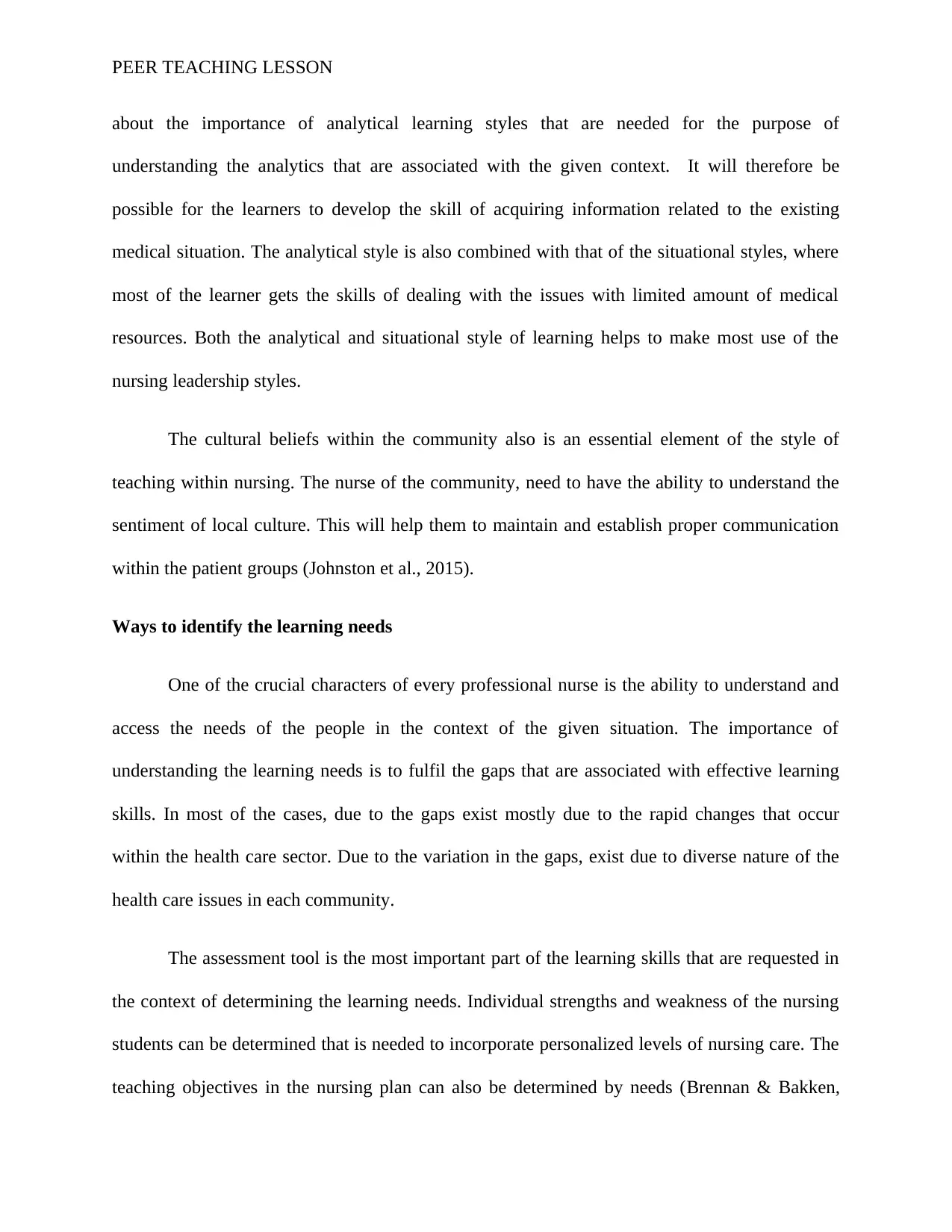
PEER TEACHING LESSON
about the importance of analytical learning styles that are needed for the purpose of
understanding the analytics that are associated with the given context. It will therefore be
possible for the learners to develop the skill of acquiring information related to the existing
medical situation. The analytical style is also combined with that of the situational styles, where
most of the learner gets the skills of dealing with the issues with limited amount of medical
resources. Both the analytical and situational style of learning helps to make most use of the
nursing leadership styles.
The cultural beliefs within the community also is an essential element of the style of
teaching within nursing. The nurse of the community, need to have the ability to understand the
sentiment of local culture. This will help them to maintain and establish proper communication
within the patient groups (Johnston et al., 2015).
Ways to identify the learning needs
One of the crucial characters of every professional nurse is the ability to understand and
access the needs of the people in the context of the given situation. The importance of
understanding the learning needs is to fulfil the gaps that are associated with effective learning
skills. In most of the cases, due to the gaps exist mostly due to the rapid changes that occur
within the health care sector. Due to the variation in the gaps, exist due to diverse nature of the
health care issues in each community.
The assessment tool is the most important part of the learning skills that are requested in
the context of determining the learning needs. Individual strengths and weakness of the nursing
students can be determined that is needed to incorporate personalized levels of nursing care. The
teaching objectives in the nursing plan can also be determined by needs (Brennan & Bakken,
about the importance of analytical learning styles that are needed for the purpose of
understanding the analytics that are associated with the given context. It will therefore be
possible for the learners to develop the skill of acquiring information related to the existing
medical situation. The analytical style is also combined with that of the situational styles, where
most of the learner gets the skills of dealing with the issues with limited amount of medical
resources. Both the analytical and situational style of learning helps to make most use of the
nursing leadership styles.
The cultural beliefs within the community also is an essential element of the style of
teaching within nursing. The nurse of the community, need to have the ability to understand the
sentiment of local culture. This will help them to maintain and establish proper communication
within the patient groups (Johnston et al., 2015).
Ways to identify the learning needs
One of the crucial characters of every professional nurse is the ability to understand and
access the needs of the people in the context of the given situation. The importance of
understanding the learning needs is to fulfil the gaps that are associated with effective learning
skills. In most of the cases, due to the gaps exist mostly due to the rapid changes that occur
within the health care sector. Due to the variation in the gaps, exist due to diverse nature of the
health care issues in each community.
The assessment tool is the most important part of the learning skills that are requested in
the context of determining the learning needs. Individual strengths and weakness of the nursing
students can be determined that is needed to incorporate personalized levels of nursing care. The
teaching objectives in the nursing plan can also be determined by needs (Brennan & Bakken,
Paraphrase This Document
Need a fresh take? Get an instant paraphrase of this document with our AI Paraphraser
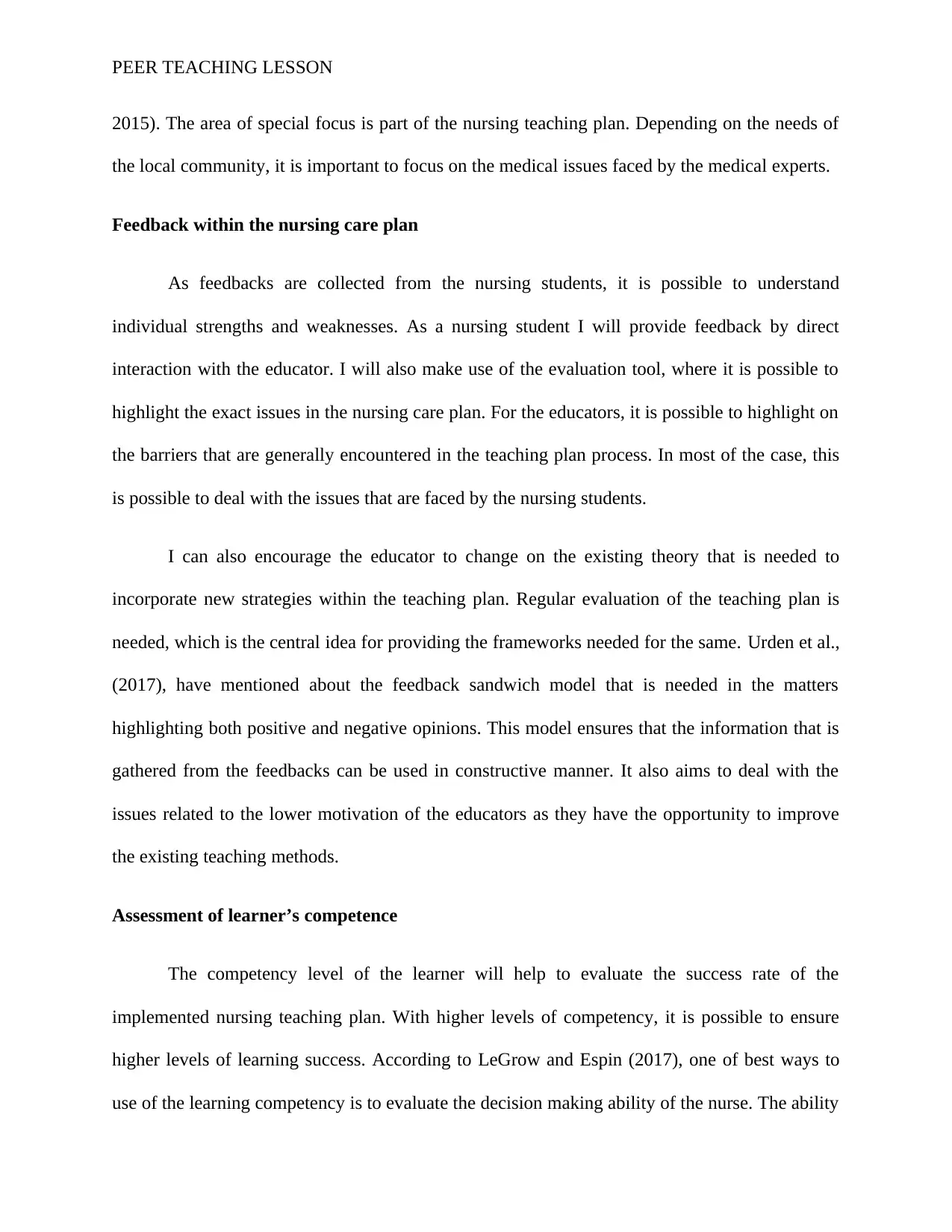
PEER TEACHING LESSON
2015). The area of special focus is part of the nursing teaching plan. Depending on the needs of
the local community, it is important to focus on the medical issues faced by the medical experts.
Feedback within the nursing care plan
As feedbacks are collected from the nursing students, it is possible to understand
individual strengths and weaknesses. As a nursing student I will provide feedback by direct
interaction with the educator. I will also make use of the evaluation tool, where it is possible to
highlight the exact issues in the nursing care plan. For the educators, it is possible to highlight on
the barriers that are generally encountered in the teaching plan process. In most of the case, this
is possible to deal with the issues that are faced by the nursing students.
I can also encourage the educator to change on the existing theory that is needed to
incorporate new strategies within the teaching plan. Regular evaluation of the teaching plan is
needed, which is the central idea for providing the frameworks needed for the same. Urden et al.,
(2017), have mentioned about the feedback sandwich model that is needed in the matters
highlighting both positive and negative opinions. This model ensures that the information that is
gathered from the feedbacks can be used in constructive manner. It also aims to deal with the
issues related to the lower motivation of the educators as they have the opportunity to improve
the existing teaching methods.
Assessment of learner’s competence
The competency level of the learner will help to evaluate the success rate of the
implemented nursing teaching plan. With higher levels of competency, it is possible to ensure
higher levels of learning success. According to LeGrow and Espin (2017), one of best ways to
use of the learning competency is to evaluate the decision making ability of the nurse. The ability
2015). The area of special focus is part of the nursing teaching plan. Depending on the needs of
the local community, it is important to focus on the medical issues faced by the medical experts.
Feedback within the nursing care plan
As feedbacks are collected from the nursing students, it is possible to understand
individual strengths and weaknesses. As a nursing student I will provide feedback by direct
interaction with the educator. I will also make use of the evaluation tool, where it is possible to
highlight the exact issues in the nursing care plan. For the educators, it is possible to highlight on
the barriers that are generally encountered in the teaching plan process. In most of the case, this
is possible to deal with the issues that are faced by the nursing students.
I can also encourage the educator to change on the existing theory that is needed to
incorporate new strategies within the teaching plan. Regular evaluation of the teaching plan is
needed, which is the central idea for providing the frameworks needed for the same. Urden et al.,
(2017), have mentioned about the feedback sandwich model that is needed in the matters
highlighting both positive and negative opinions. This model ensures that the information that is
gathered from the feedbacks can be used in constructive manner. It also aims to deal with the
issues related to the lower motivation of the educators as they have the opportunity to improve
the existing teaching methods.
Assessment of learner’s competence
The competency level of the learner will help to evaluate the success rate of the
implemented nursing teaching plan. With higher levels of competency, it is possible to ensure
higher levels of learning success. According to LeGrow and Espin (2017), one of best ways to
use of the learning competency is to evaluate the decision making ability of the nurse. The ability
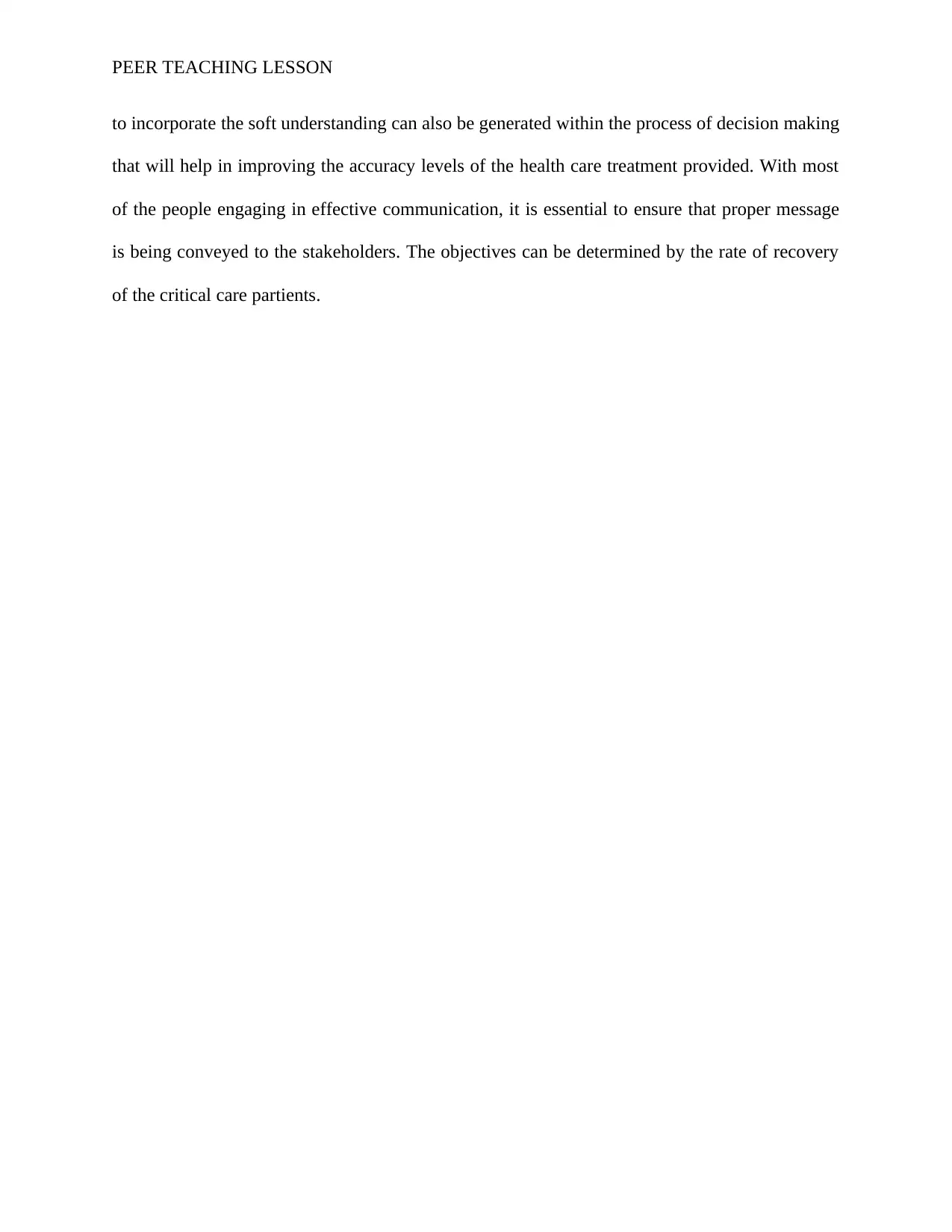
PEER TEACHING LESSON
to incorporate the soft understanding can also be generated within the process of decision making
that will help in improving the accuracy levels of the health care treatment provided. With most
of the people engaging in effective communication, it is essential to ensure that proper message
is being conveyed to the stakeholders. The objectives can be determined by the rate of recovery
of the critical care partients.
to incorporate the soft understanding can also be generated within the process of decision making
that will help in improving the accuracy levels of the health care treatment provided. With most
of the people engaging in effective communication, it is essential to ensure that proper message
is being conveyed to the stakeholders. The objectives can be determined by the rate of recovery
of the critical care partients.
⊘ This is a preview!⊘
Do you want full access?
Subscribe today to unlock all pages.

Trusted by 1+ million students worldwide
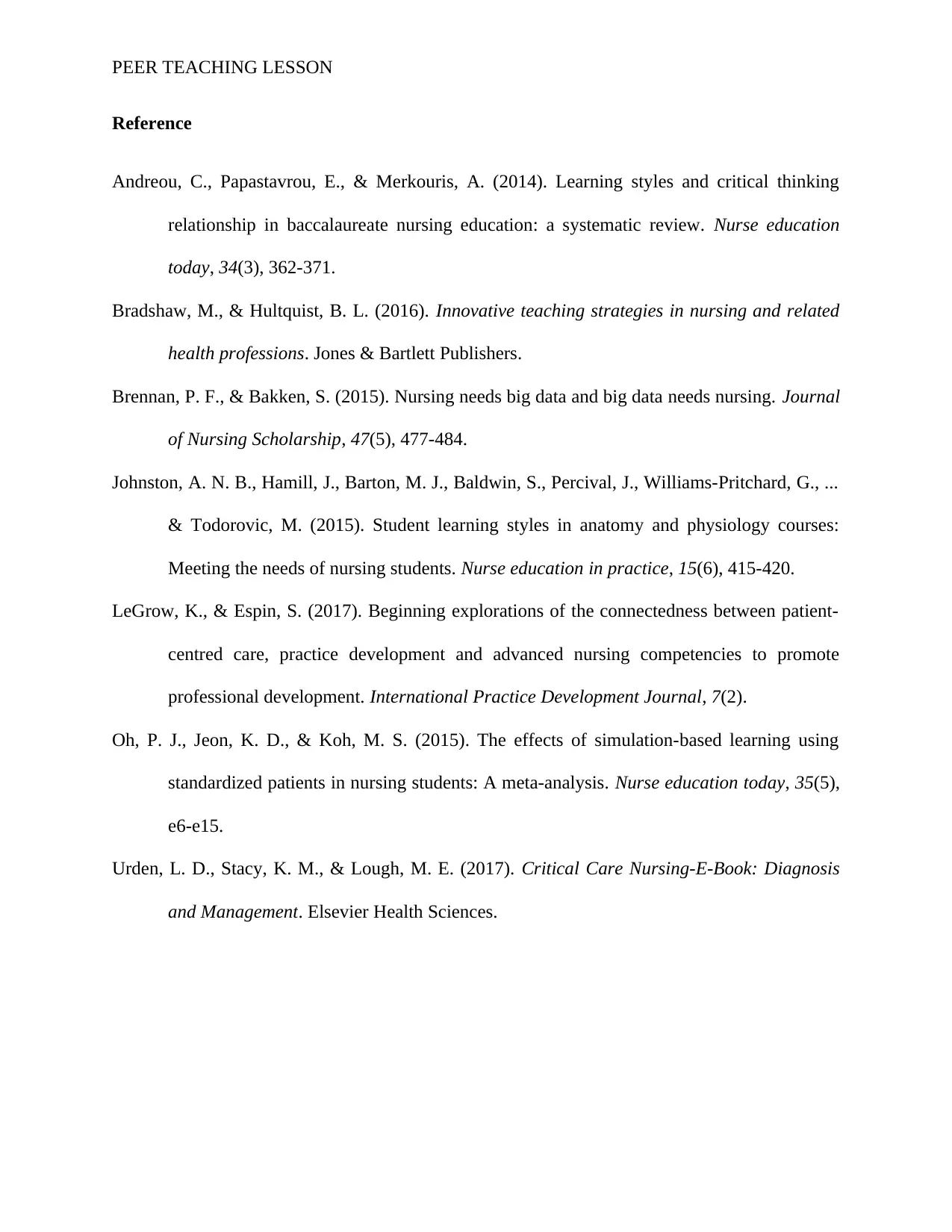
PEER TEACHING LESSON
Reference
Andreou, C., Papastavrou, E., & Merkouris, A. (2014). Learning styles and critical thinking
relationship in baccalaureate nursing education: a systematic review. Nurse education
today, 34(3), 362-371.
Bradshaw, M., & Hultquist, B. L. (2016). Innovative teaching strategies in nursing and related
health professions. Jones & Bartlett Publishers.
Brennan, P. F., & Bakken, S. (2015). Nursing needs big data and big data needs nursing. Journal
of Nursing Scholarship, 47(5), 477-484.
Johnston, A. N. B., Hamill, J., Barton, M. J., Baldwin, S., Percival, J., Williams-Pritchard, G., ...
& Todorovic, M. (2015). Student learning styles in anatomy and physiology courses:
Meeting the needs of nursing students. Nurse education in practice, 15(6), 415-420.
LeGrow, K., & Espin, S. (2017). Beginning explorations of the connectedness between patient-
centred care, practice development and advanced nursing competencies to promote
professional development. International Practice Development Journal, 7(2).
Oh, P. J., Jeon, K. D., & Koh, M. S. (2015). The effects of simulation-based learning using
standardized patients in nursing students: A meta-analysis. Nurse education today, 35(5),
e6-e15.
Urden, L. D., Stacy, K. M., & Lough, M. E. (2017). Critical Care Nursing-E-Book: Diagnosis
and Management. Elsevier Health Sciences.
Reference
Andreou, C., Papastavrou, E., & Merkouris, A. (2014). Learning styles and critical thinking
relationship in baccalaureate nursing education: a systematic review. Nurse education
today, 34(3), 362-371.
Bradshaw, M., & Hultquist, B. L. (2016). Innovative teaching strategies in nursing and related
health professions. Jones & Bartlett Publishers.
Brennan, P. F., & Bakken, S. (2015). Nursing needs big data and big data needs nursing. Journal
of Nursing Scholarship, 47(5), 477-484.
Johnston, A. N. B., Hamill, J., Barton, M. J., Baldwin, S., Percival, J., Williams-Pritchard, G., ...
& Todorovic, M. (2015). Student learning styles in anatomy and physiology courses:
Meeting the needs of nursing students. Nurse education in practice, 15(6), 415-420.
LeGrow, K., & Espin, S. (2017). Beginning explorations of the connectedness between patient-
centred care, practice development and advanced nursing competencies to promote
professional development. International Practice Development Journal, 7(2).
Oh, P. J., Jeon, K. D., & Koh, M. S. (2015). The effects of simulation-based learning using
standardized patients in nursing students: A meta-analysis. Nurse education today, 35(5),
e6-e15.
Urden, L. D., Stacy, K. M., & Lough, M. E. (2017). Critical Care Nursing-E-Book: Diagnosis
and Management. Elsevier Health Sciences.
Paraphrase This Document
Need a fresh take? Get an instant paraphrase of this document with our AI Paraphraser
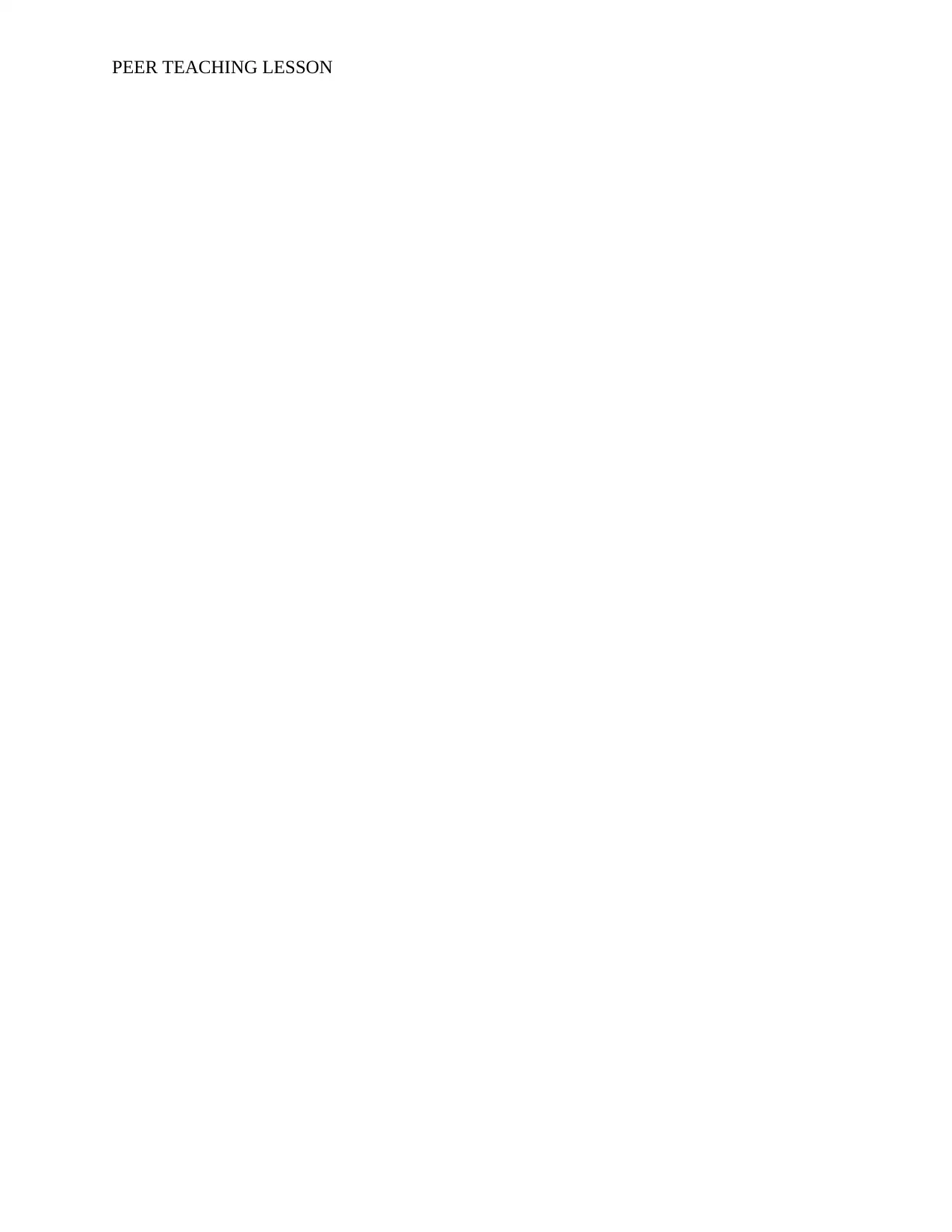
PEER TEACHING LESSON
1 out of 8
Related Documents
Your All-in-One AI-Powered Toolkit for Academic Success.
+13062052269
info@desklib.com
Available 24*7 on WhatsApp / Email
![[object Object]](/_next/static/media/star-bottom.7253800d.svg)
Unlock your academic potential
Copyright © 2020–2025 A2Z Services. All Rights Reserved. Developed and managed by ZUCOL.





